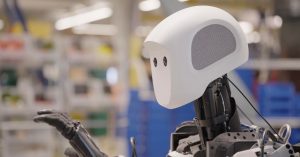Box culture dominates life. Humans are comfortable with boxed-up products, services and things if they can be compartmentalized and created or delivered in a form that offers a clearly defined shape. We buy shoes in box, we often buy fruit in a box and we life to talk about so-called Commercial-Off-The-Shelf (COTS) products and services that may not always come in a physical box, but are nonetheless defined as a boxed-up offering.
We’ve even taken to living, working, shopping and eating in boxes – just look at the rise of ISO intermodal freight containers in the creation of what are now being called ‘containerpark’ sites everywhere from Las Vegas to London.
This process happens in technology too. We’ve seen COTS software suites offered many times over the years, particularly if we think back to pre-web CD-ROM era throughout the 1980s and 1990s. When we bought Microsoft Office, Adobe Creative Suite or Norton Anti-Virus (other software packages are/were also available), we bought them in a box.
Part-baked & oven-ready
Not to be confused with the commoditization of software – the point at which any given IT service becomes indistinguishable from others over and above its price – the compartmentalization of software and IT services into a boxed format today is often meant to express its pre-engineered, pre-architected and pre-provisioned (possibly part-baked oven-ready) status, all of which is meant to make it easier to deploy.
With so much discussion surrounding the use of generative Artificial Intelligence (gen-AI) and the use of ChatGPT-derived (the GPT part denoting Generative Pre-trained Transformer, a type of AI that gets its intelligence from Large Language Models of human words) intelligence, it is perhaps no surprise to see this technology being compartmentalized in line with the wider trend proposed here so far. Among the firms now looking to bring this efficiency to market is hybrid multi-cloud platform company Nutanix.
By bringing forward what it calls Nutanix GPT-in-a-Box, the company says it has created a technology for organizations who want to jump-start their work with AI and Machine Learning (ML), but still retain full control over their data. This is a software-defined AI-ready platform, along with services to help organizations size and configure hardware and software infrastructure suitable to deploy a curated set of Large Language Models (LLMs) using the open source AI and MLOps frameworks on the Nutanix Cloud Platform.
In simple terms, it is built to enable organizations to purchase, position, prepare and push forward AI-ready infrastructure to fine-tune and run generative pre-trained transformers (GPTs), including LLMs. In other words, this is boxed-up cloud foundations for new-age AI.
An ‘opinionated’ AI-ready stack
“Helping customers tackle the biggest challenges they face in IT is at the core of what we do, from managing increasing multi-cloud complexity, to data protection challenges, and now adoption of generative AI solutions while keeping control over data privacy and compliance,” said Thomas Cornely, SVP of product management at Nutanix. “Nutanix GPT-in-a-Box is an opinionated AI-ready stack [i.e. one that is prealigned, provisioned and prepared] that aims to solve the key challenges with generative AI adoption and help jumpstart AI innovation.”
Cornely and team point to the reality of AI implementation in real world businesses. He suggests that many firms find it tough to know how to quickly, efficiently and securely take advantage of generative AI and AI/ML applications. This challenge is logically made even tougher when there is a question of data sovereignty and governance in the implementation.
“New use cases emerge every day as organisations look to leverage generative AI to improve customer service, developer productivity, operational efficiency and more. From the automated transcription of internal documents, to high-speed search of multimedia content and automated analysis, many organizations see the opportunity with AI but are struggling with growing concerns regarding intellectual property leakage, compliance and privacy concerns,” details Nutanix, in a technical product statement.
ML administrators are real people
If we accept the technology proposition being put forward here by Nutanix (i.e. that the GPT end of generative AI is rarely a point-and-click plug-and-play solution and that a degree of ‘boxing’ as evidenced here can make adoption of this technology more manageable), then we can perhaps see how tough it is to deploy complex new AI & ML systems in real world environments. Not least of the challenges on the road to building an AI-ready stack is the need to support ML administrators and data scientists in the workplace. In some firms, this core human factor may be the reason why the prospect of large AI investment costs has enterprises stalled a company’s AI and ML strategy.
The Nutanix GPT-in-a-Box offering is ready-to-use customer-controlled AI infrastructure for the Internet of Things (IoT) edge, or the core datacenter. It allows our poor ML administrators and data scientists to run and fine-tune AI and GPT models with a full complement of security and data protection offerings ideal for AI data protection
According to the company, the Nutanix GPT-In-a-Box solution builds on the full stack scalability, performance, resilience and ease of use that the Nutanix Cloud Platform is known for. The team behind this new technology package claim to have expertize with scalable infrastructure across public cloud, datacenter and edge use cases. All of which combined efforts are said to deliver an environment to fine-tune and run AI applications.
Are we living in a box?
Is box-based delivery logic the way forward for all complex technologies? Yes and no. There will be organizations that have dedicated teams well-versed in AI implementations at all levels. Indeed, some organizations most adept at working with the still-nascent world of gen-AI, Large Language Models (LLMs) and GPT technologies will be active innovators and leaders in this space and may also be involved with contributing to industry standards, major scale open source projects and other initiatives in this space.
But for many – and this is presumably where Nutanix eyes the low-hanging fruit – a specialism in this zone of technology will be a big ask and more than any one IT department can quickly shoulder as it works to just ‘keep the lights on’ and run the business.
Not all technology comes in a box, but where it does, it’s not like a box of chocolates, you pretty much always know what you are going to get.
Read the full article here









